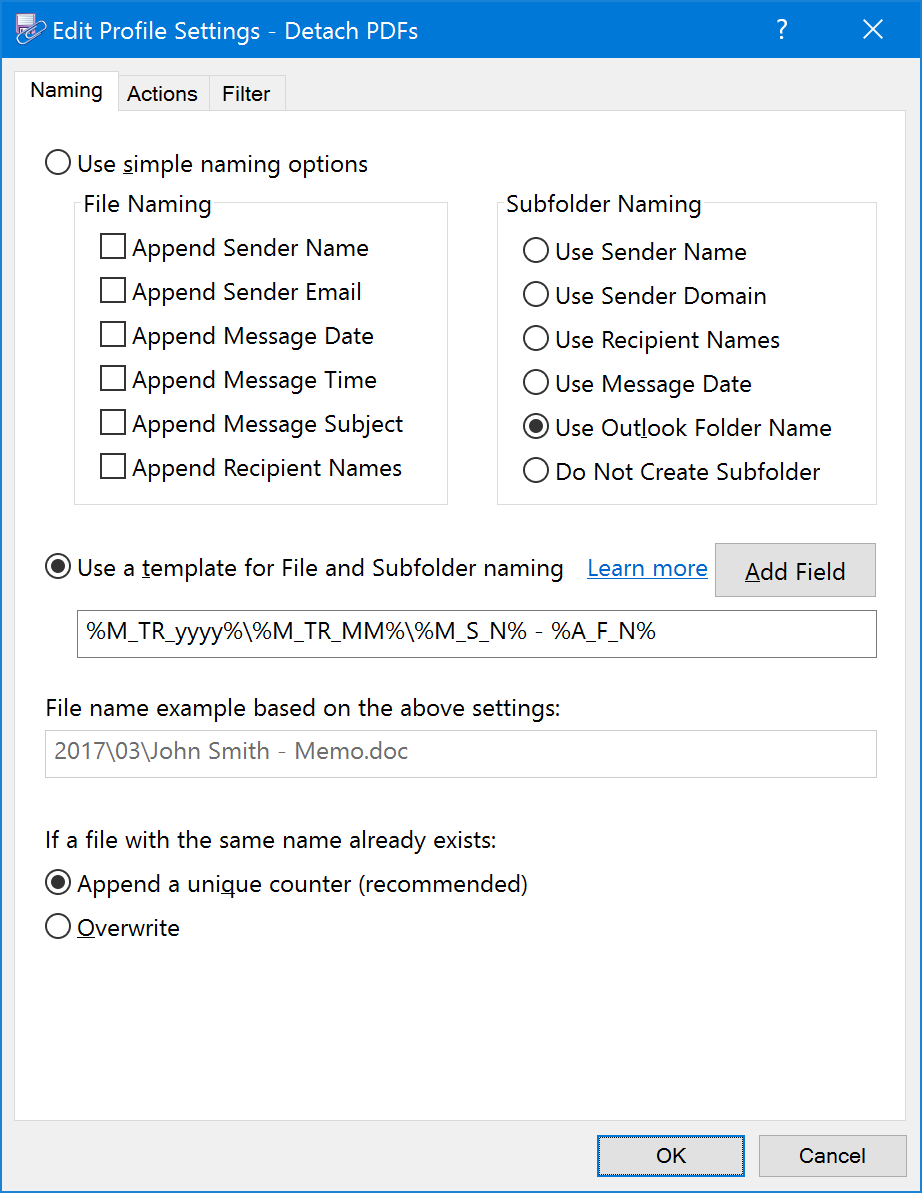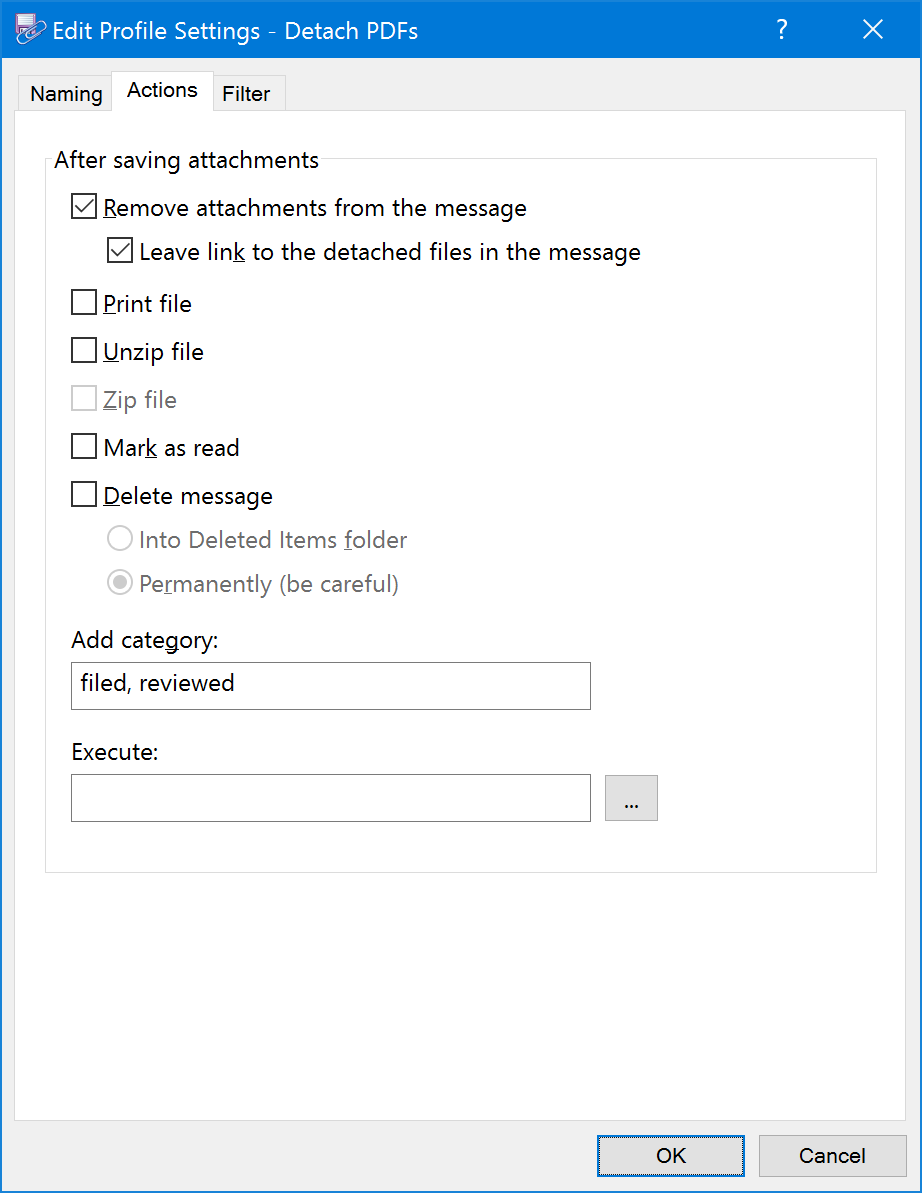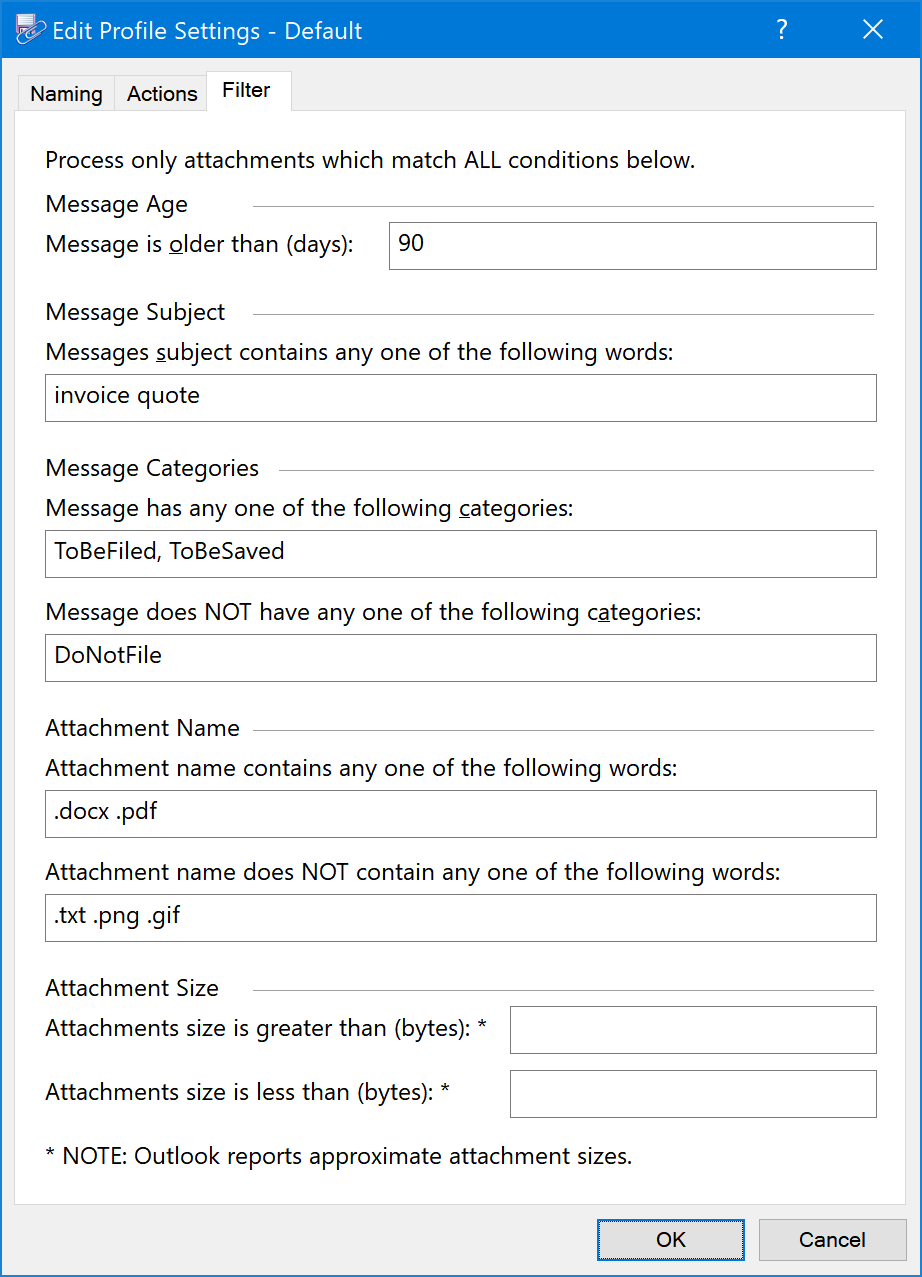Edit Profile Window¶
Edit Profile Window allows you to configure options like:
- Custom file naming format - customize things like date format, field order, etc.
- Configure actions to perform after saving attachments.
- Filter what attachments to save.
Naming Tab¶

Here you configure how EZDetach generates file names for the saved attachments. Two naming modes are supported:
- Simple naming options for simple configuration
- Template For File And Subfolder Naming for flexible configuration which should support any naming requirements you might have and match your organization naming conventions.
Note
EZDetach always sets the “Date Modified” field on saved files to the time when the corresponding message was received. You can click on the “Date Modified” header in File Explorer to sort saved messages in chronological order.
-
Simple Naming Options¶ A set of checkboxes to add various message attributes to the file name and to optionally select one level subfolder structure. If you need more flexibility or an ability to change field order, please use the “Template” method below.
-
Append Sender Name¶ Enable this option to include the name of the person who sent the message in the name of the file. For example, if the sender name is
John Smithand the attachment name isMemo.docxthe generated file name would beJohn Smith - Memo.docx.
-
Append Sender Email¶ Enable this option to include the email address of the person who sent the message in the name of the file.
-
Append Message Date¶ Enable this option to include the “message received” date in the name of the file. Date is formatted as
YYYY-MM-DD. If you would like to use a different format, you can configure it using Template For File And Subfolder Naming.
-
Append Message Time¶ Enable this option to include the “message received” time in the name of the file. Time is formatted as
hh-mm-ss. If you would like to use a different format, you can configure it using the Template For File And Subfolder Naming.
-
Append Recipient Names¶ Enable this option to include names of message recipients in the name of the file. If you would like to control how recipients are formatted (Names vs Emails, All vs “To” only), you can do so using the Template For File And Subfolder Naming.
-
-
Subfolder Naming Options¶ Subfolder naming controls how EZDetach generates folder names for the saved files. Here you can check only one option. If you would like more flexibility in subfolder naming, please use the Template For File And Subfolder Naming.
-
Use Sender Name¶ Create subfolders using the name of the message sender. For example, if you receive an attachment from
John Smithwith nameMemo.docx, with this option ON, it would be saved in theJohn Smithsubfolder of the Destination Folder -John Smith\Memo.docx
-
Use Recipient Names¶ Use message recipient names as a subfolder name.
-
Use Sender Domain¶ Use sender domain name as the subfolder name. For example,
techhit.com\Memo.docx.
-
Use Message Date¶ Use Message Date as the subfolder name. Date format is
YYYY-MM-DD. Use the Template For File And Subfolder Naming to configure a different format.
-
Use Outlook Folder Name¶ Duplicate Outlook folder hierarchy in the file system. EZDetach will create the same folder tree as what you have in Outlook.
-
Do Not Create Subfolder¶ Do not create subfolders. Save messages directly in the Destination Folder.
-
-
Template For File And Subfolder Naming¶ Templates are a flexible mechanism for specifying file and folder naming. A template consists of fields, which are replaced with values from the messages you are saving. For example,
%A_F_N%is replaced with attachment name;%M_SUBJ%is replaced with a message subject. Use the Add Field button to insert fields. You can also manually type additional values, such as separators. See File Name Templates for details on template syntax.-
Add Field¶ Use this button to insert template fields from the menu it provides.
-
-
File Name Example¶ Displays a sample file name, based on what you have configured above.
-
If A File With The Same Name Already Exists¶ -
Append a unique counter¶ If this option is ON, EZDetach will generate unique file name whenever you try to save a message and a file with the same name already exists. For example, the first time you try to save a message which maps to
John Smith - Memo.docx, that is the name that is used. The second time, the file will be namedJohn Smith - Memo - 1.docx. After that,John Smith - Memo - 2.docx, and so on.
-
Overwrite¶ If you enable this option, EZDetach will NOT generate a unique name by appending a counter. In the example above, if a file with the name
John Smith - Memo.docxalready existed in the destination folder, EZDetach would overwrite it with the new message.If you include sender name as well as date and time into the file name, and you are confident that you are unlikely to receive more than one message from the same sender within one second, you can enable this option if you are saving messages from different computers or by different users and are concerned about file duplication.
Warning
Please be sure you understand this option before enabling it!
-
Actions Tab¶

Configure actions to be performed after saving attachments.
-
Remove Attachments From Messages¶ Remove attachments after saving them as files.
-
Leave A Link To The Detached File In The Message¶ Replace the original attachments with attachment links. Attachment links behave very much like the original attachments. They preserve the attachment indicator (paperclip); you can double-click on a link to open the original file. The major benefit of attachment links is that they are much smaller than the original attachments. Instead of many kilobytes (or sometimes even megabytes), the links only take several hundred bytes each. See Attachment Links for details.
-
Print¶ Print attachments to the default printer.
Note
In order for EZDetach to be able to print a particular file type, your system has to be configured for it. If you are able to right-click on a file in Windows File Explorer, click “Print” and print it successfully, EZDetach should be able to print it as well.
-
Zip File¶ Zip files after saving them.
-
Unzip File¶ Unzip files after saving them. This option only supports .zip files. Other compressed formats, such as .rar, .7z, etc. are not supported.
-
Mark As Read¶ Mark messages as read after saving.
-
Delete message¶ Remove messages from Outlook after saving attachments from them.
-
Into Deleted Items Folder¶ Move into Deleted Items.
-
Permanently¶ Delete permanently.
Warning
Be careful when you enable this option. Messages are not moved to Deleted Items. They are removed permanently. If you use the .msg format for saving (which is the default), you can still restore messages by dragging and dropping .msg files into an Outlook folder.
-
-
Add Category¶ Assign an Outlook category to messages. Type category name into this field. Separate multiple categories with a comma.
-
Execute¶ Execute a custom script, provided by you, on the saved files. This is a very flexible option which allows you to automate email attachment processing without having to interface with Outlook directly.
For example, you can use it for things like:
- Automatically process email from vendors.
- Import attachments into a document management system.
- Run reports on the contents of your mailbox.
See EZDetach API reference for details.
Filter Tab¶
Specify criteria for the messages you would like to save.

-
Message Age Filter¶ Allows you to specify that you would like to only save attachments from messages which have been received over this many days ago.
-
Message Subject Filter¶ You can use the Subject Filter to only save attachments from messages with certain words in the subject. Use multiple space-separated words to match on several topics. For example, filter
invoice quotewill match all messages with either wordinvoiceor wordquotein the subject.
-
Message Category Filter¶ You can use the Category Filter to only save attachments from messages labeled with certain categories or messages which do not have certain categories. You can enter multiple comma-separated categories. For example, filter
Cat1, Cat2, Cat3will match messages with any of the three categories -Cat1,Cat2orCat3.
-
Attachment Name Filter¶ Use Attachment Name Filter to only save attachments with names which match the words you specify. You can use multiple space-separated words. For example, filter
.docx .pdf .xlsxwill match all attachments with either.docxor.pdfor.xlsxin the file name.
-
Attachment Size Filter¶ Here you can filter attachments by size. Please note that Outlook sometimes reports approximate attachment sizes, which means that attachments size filter matching is approximate.
Tip
If you require more advanced filtering, you can use Outlook built-in Search or Search Folders. Wait for the results to populate, then select all messages in the result set and run EZDetach on them. This integration allows you to use the full filtering power of Outlook with EZDetach saving capabilities.